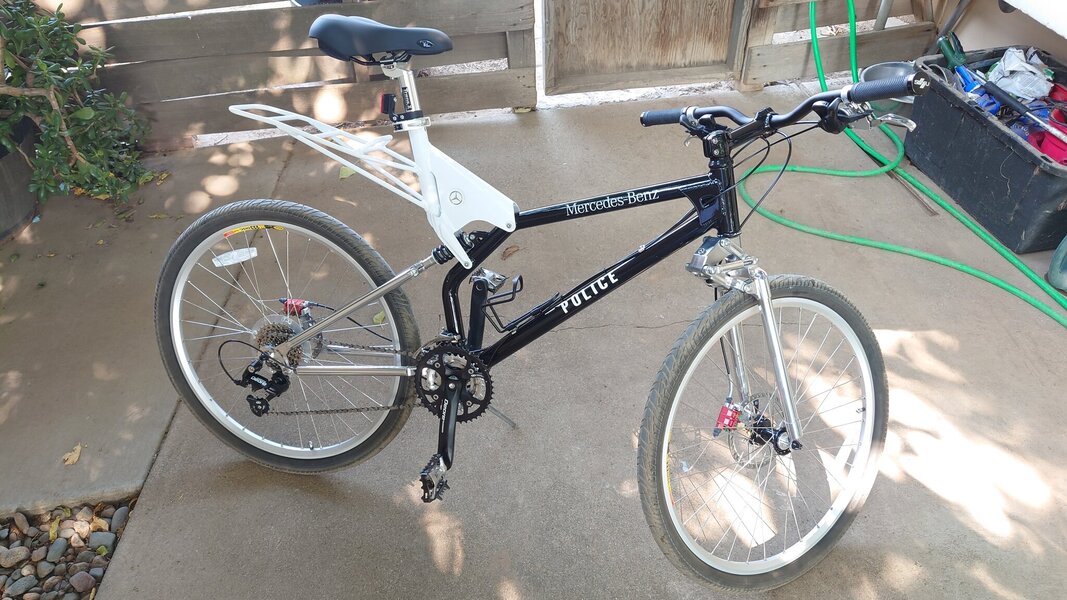Hi I am new to The forum and this is my first time using a blog site so if I'm doing it wrong I apologize. My question is there somebody selling AMP research b4 disc brake conversion kits on ebay I would like to get a hold of him because I just missed out on a sale and would like to know if he is going to be making some more soon. Thank you
You are using an out of date browser. It may not display this or other websites correctly.
You should upgrade or use an alternative browser.
You should upgrade or use an alternative browser.
AMP research brake caliper
- Thread starter Dougamts
- Start date
https://www.retrobike.co.uk/threads/amp-disc-brake-conversion-kits-available.428101/
Bear in mind that the forks are not made for the loadings of current disc brake standards and rotor diameters, there are problems with modern rotor clearance at the chainstay pivot bolt. You will also need to change out your hubs too, as they are not compatible with post year 2000 brakes.
If you go ahead, definitely no rotors bigger than 160mm, preferably 140mm. The originals are 133mm rear and 163.5 front, with 25 yr old cable actuated caliper technology.
On the plus side, your original, good condition brake calipers and hubs as a complete set would be worth perhaps £250 to the right buyer. See Amp'oholics group on Facebook.
All the best,
Bear in mind that the forks are not made for the loadings of current disc brake standards and rotor diameters, there are problems with modern rotor clearance at the chainstay pivot bolt. You will also need to change out your hubs too, as they are not compatible with post year 2000 brakes.
If you go ahead, definitely no rotors bigger than 160mm, preferably 140mm. The originals are 133mm rear and 163.5 front, with 25 yr old cable actuated caliper technology.
On the plus side, your original, good condition brake calipers and hubs as a complete set would be worth perhaps £250 to the right buyer. See Amp'oholics group on Facebook.
All the best,
Last edited:
2manyoranges
Senior Retro Guru
- Feedback
- View
Everything which Danson so wisely said. I am a long standing AMP owner, having used forks and frame in earnest on very demanding off road. The forks are terrifyingly flexible when used in anger off road. There’s nothing wrong with the design, they were pursuing specific goals of lightness and performance and they are IN NO WAY designed for the brake loads of current disc systems. I would service the existing brakes or - my preference - used V brakes on the front. Where are you and what will you be using the bike for?
I would say that it’s a big NO to trying to use modern large rotor discs on the forks. Rear is OK, but I would keep it as a period bike.
I would say that it’s a big NO to trying to use modern large rotor discs on the forks. Rear is OK, but I would keep it as a period bike.
Interesting stuff. I'm planning on using newer brakes on my litespeed obed fs with amp forks. Hope mini was going to be my brake of choice. Seems that I should use a 140mm out back and 160mm up front and no more.
Are the forces of modern brakes that much more? I did post a while back about this but didn't really get any useful replies.
Are the forces of modern brakes that much more? I did post a while back about this but didn't really get any useful replies.
2manyoranges
Senior Retro Guru
- Feedback
- View
I did mull about this Ian - there's little research that has been done to quantify precisely the improvement in brakes. As usual, I have done a search of research just as a check. There's really not very much - only one paper (which I can't access the tables for) which compares different brake types. And there's this:
....which has an interesting table of relative force depending on disc diameter. A very significant rise in % terms for the move from 160 to 200.
There are many mentions in articles of 'research which shows disc brakes to be superior' and almost no well-designed research to be found. Odd. I have used almost every type of brake, and know that U brake, roller cam, cantilever and v brakes all vary massively in performance according to set up and lad material. From that experience, for an AMP I would place the following hierarchy:
1 = worst, ascending = better.
1 = AMP disc brake
2 = cantilever
3 = V brake
4 = modern disc brake
this discussion corroborates that:

 www.mtbr.com
www.mtbr.com
The thing about the V brake placement is that this is way up the AMP fork leg, towards the steer tube and crown - compared with the disc brake, which acts through the hub flange. Initially I thought that this would place less stress on the fork and mean less fork flex, since the brake is applying its force closer to the crown. A moment's thought makes it clear that this is very complex, since the braking force might be applied nearer to the crown, but has to act through the interaction of the tyre with the road surface. The pulls the crown forward and the lower part of the fork leg backwards. Applying the braking force lower in the fork actually leads to less distance between the opposing forces, but you still have the big mass of the rider and bike acting through the system....bending the fork. The essential fact remains...AMP forks are terrifyingly flexible. I remember getting maybe 4cm (!!!!) of flex at the front dropout when really hooning on the brake on a downhill. That's scary. I mean, modern 36mm forks don't flex at all...right? Wrong.
Blimey. So if I can SEE the AMP fork moving 4cm using V brakes.....gulp.
And aluminium is not exactly good at going through stress cycles.....more gulp.
And with the general consensus and empirical evidence being that modern discs are a hell of a lot more powerful than V brakes - skip to 9:30
Then putting even a 160 on an AMP fork is going to push a hell of a lot more energy through the forks. Personally, with that flexing being seared in my mind means - no way would I put a modern disc brake on an AMP fork.
Just out of interest....
This pair are a bit extreme in pushing modern brakes...
and this is an interesting vid too...
....which has an interesting table of relative force depending on disc diameter. A very significant rise in % terms for the move from 160 to 200.
There are many mentions in articles of 'research which shows disc brakes to be superior' and almost no well-designed research to be found. Odd. I have used almost every type of brake, and know that U brake, roller cam, cantilever and v brakes all vary massively in performance according to set up and lad material. From that experience, for an AMP I would place the following hierarchy:
1 = worst, ascending = better.
1 = AMP disc brake
2 = cantilever
3 = V brake
4 = modern disc brake
this discussion corroborates that:

I just put ISO mount disc brakes on my old AMP fork.
I had a machine shop make me an adapter plate to run my NEW Shimano four piston brakes (love eBay). The plate is very utilitarian, but I will sculpt it out a little for weight and esthetics after a few test rides. I will post a picture once there is something better to look at.
The thing about the V brake placement is that this is way up the AMP fork leg, towards the steer tube and crown - compared with the disc brake, which acts through the hub flange. Initially I thought that this would place less stress on the fork and mean less fork flex, since the brake is applying its force closer to the crown. A moment's thought makes it clear that this is very complex, since the braking force might be applied nearer to the crown, but has to act through the interaction of the tyre with the road surface. The pulls the crown forward and the lower part of the fork leg backwards. Applying the braking force lower in the fork actually leads to less distance between the opposing forces, but you still have the big mass of the rider and bike acting through the system....bending the fork. The essential fact remains...AMP forks are terrifyingly flexible. I remember getting maybe 4cm (!!!!) of flex at the front dropout when really hooning on the brake on a downhill. That's scary. I mean, modern 36mm forks don't flex at all...right? Wrong.
Blimey. So if I can SEE the AMP fork moving 4cm using V brakes.....gulp.
And aluminium is not exactly good at going through stress cycles.....more gulp.
And with the general consensus and empirical evidence being that modern discs are a hell of a lot more powerful than V brakes - skip to 9:30
Then putting even a 160 on an AMP fork is going to push a hell of a lot more energy through the forks. Personally, with that flexing being seared in my mind means - no way would I put a modern disc brake on an AMP fork.
Just out of interest....
This pair are a bit extreme in pushing modern brakes...
and this is an interesting vid too...
Last edited:
luciends13
Retro Newbie
Similar threads
- Replies
- 7
- Views
- 666
- Replies
- 22
- Views
- 3K
